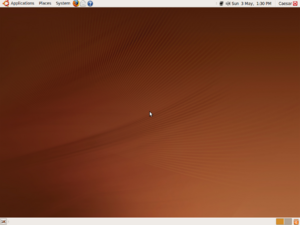Ubuntu (Linux distribution): Difference between revisions
imported>Caesar Schinas m (Added Image:Ubuntu screenshot.png) |
imported>Caesar Schinas |
||
| Line 1: | Line 1: | ||
{{subpages}} | {{subpages}} | ||
{{dambigbox|Ubuntu Linux|Ubuntu}} | |||
{{Template:Infobox_Software | {{Template:Infobox_Software | ||
| name = Ubuntu | | name = Ubuntu | ||
| Line 14: | Line 15: | ||
| ui = [[Gnome]] | | ui = [[Gnome]] | ||
}} | }} | ||
'''Ubuntu''' is a [[Debian]]-based distribution of the [[Linux]] operating system created by [[Canonical Ltd.]] It is based on the ideas of the [[Ubuntu (philosophy) | Ubuntu philosophy]] ("humanity towards others"). Its slogan is "Linux for human beings", reflecting its focus on ease of use. The latest release is 8.04, codenamed "Hardy Heron" and is now the latest "Long Term Support" release. | '''Ubuntu''' is a [[Debian]]-based distribution of the [[Linux]] operating system created by [[Canonical Ltd.]] It is based on the ideas of the [[Ubuntu (philosophy) | Ubuntu philosophy]] ("humanity towards others"). Its slogan is "Linux for human beings", reflecting its focus on ease of use. The latest release is 8.04, codenamed "Hardy Heron" and is now the latest "Long Term Support" release. | ||
Revision as of 08:20, 3 May 2009
| Ubuntu | |
|---|---|

| |

| |
| Website | www.ubuntu.com |
| Developed by | Canonical Ltd |
| Software type | Operating System |
| Latest release | 9.04, 23rd April 2009 |
| Source model | Open Source |
| Licence | GPL |
| OS Family | GNU/Linux |
| Kernel Type | Monolithic (Linux) |
| Default UI | Gnome |
Ubuntu is a Debian-based distribution of the Linux operating system created by Canonical Ltd. It is based on the ideas of the Ubuntu philosophy ("humanity towards others"). Its slogan is "Linux for human beings", reflecting its focus on ease of use. The latest release is 8.04, codenamed "Hardy Heron" and is now the latest "Long Term Support" release.
Development cycle
A new version of Ubuntu is released every six months i.e. every April and October. The version number is made up of the year and the month that it was released. For example, Ubuntu 7.10 means that it was released in October (from the "10") 2007 (from the "07"). After a release, development of the next release begins very quickly, to keep up with the 6 month release cycle. Each development cycle has Alpha releases, a Beta release and a Release Candidate before the final release.
The Ubuntu developers take a snapshot of the Debian Unstable repositories. They then focus on ensuring that all of these packages work, and upload newer version of packages when necessary. The release dates are designed so that new versions of the X Window System and GNOME can be included.
History and releases
4.04 Warty Warthog
| Release date: | 2004-10-20 |
| Supported until: | 2006-04-30 |
This was the first release of Ubuntu. At this time, the most popular Linux distributions were SUSE, Red Hat and Mandrake (now named Mandriva). Ubuntu began as a fork of Debian Unstable. The difference was that there would be regularly releases every six months, and releases would be based on a snapshot of Debian Unstable, allowing Ubuntu releases to be heavily tested before release. This was in contrast to Debian, where the only heavily-tested release is the Stable version, which is criticized for being out of date.
The release included version 2.6.7 of the Linux kernel, XFree86 4.3.0.1 and the GNOME 2.8 desktop. It was distributed in two CDs - the LiveCD (available for the x86 architecture only) and the Installation CD (available for Intel x86, AMD64 and PowerPC)
4.10 - Hoary Hedgehog
| Release date: | 2005-04-08 |
| Supported until: | 2006-10-31 |
This release included LiveCDs for all supported architectures. It included a graphical package installation and removal program and a tool to upgrade between releases. It also had support for suspending and hibernating laptops
5.10 - Breezy Badger
| Release date: | 2005-10-13 |
| Supported until: | 2007-04-13 |
6.06 LTS - Dapper Drake
| Release date: | 2006-06-01 |
| Supported on desktops until: | 2009-06 |
| Supported on servers until: | 2011-06 |
6.10 - Edgy Eft
| Release date: | 2008-04 |
| Supported until: | 2008-10 |
7.04 - Feisty Fawn
| Release date: | 2007-10-18 |
| Supported until: | 2009-04 |
7.10 - Gutsy Gibbon
| Release date: | 2007-10-18 |
| Supported until: | 2009-04 |
8.04 LTS - Hardy Heron
| Release date: | 2008-04-24 |
| Supported on desktops until: | 2011-04 |
| Supported on servers until: | 2013-04 |
8.10 - Intrepid Ibex
| Release date: | 2008-10-30 |
| Supported until: | 2010-04 |
User interface
Ubuntu uses the GNOME desktop environment. It includes graphical applications for most tasks, although it does still have a fully operational command line. The default look is the "Human" theme, which uses a caramel color in the active windows and menu items. Support for KDE is also available through installing the "kubuntu-desktop" package, or the Kubuntu distribution. Xubuntu does simlarly for those who want to use the lightweight xfce window manager.
Distribution
Ubuntu was originally distributed in two versions: a LiveCD and a text-based installation CD, and users were not able to install Ubuntu to the hard disk drive from the LiveCD. Now, however, Ubuntu releases have a graphical installer on the LiveCD, named Ubuquity, meaning that users can try the system before installing it, all on the same CD. There is also an option of a server CD, designed so that no graphical desktop is installed.
Canonical also run a system named "Shipit"; they ship CDs of the latest (and latest LTS) release completely free of charge to users. They are the only major Linux distribution to do this.